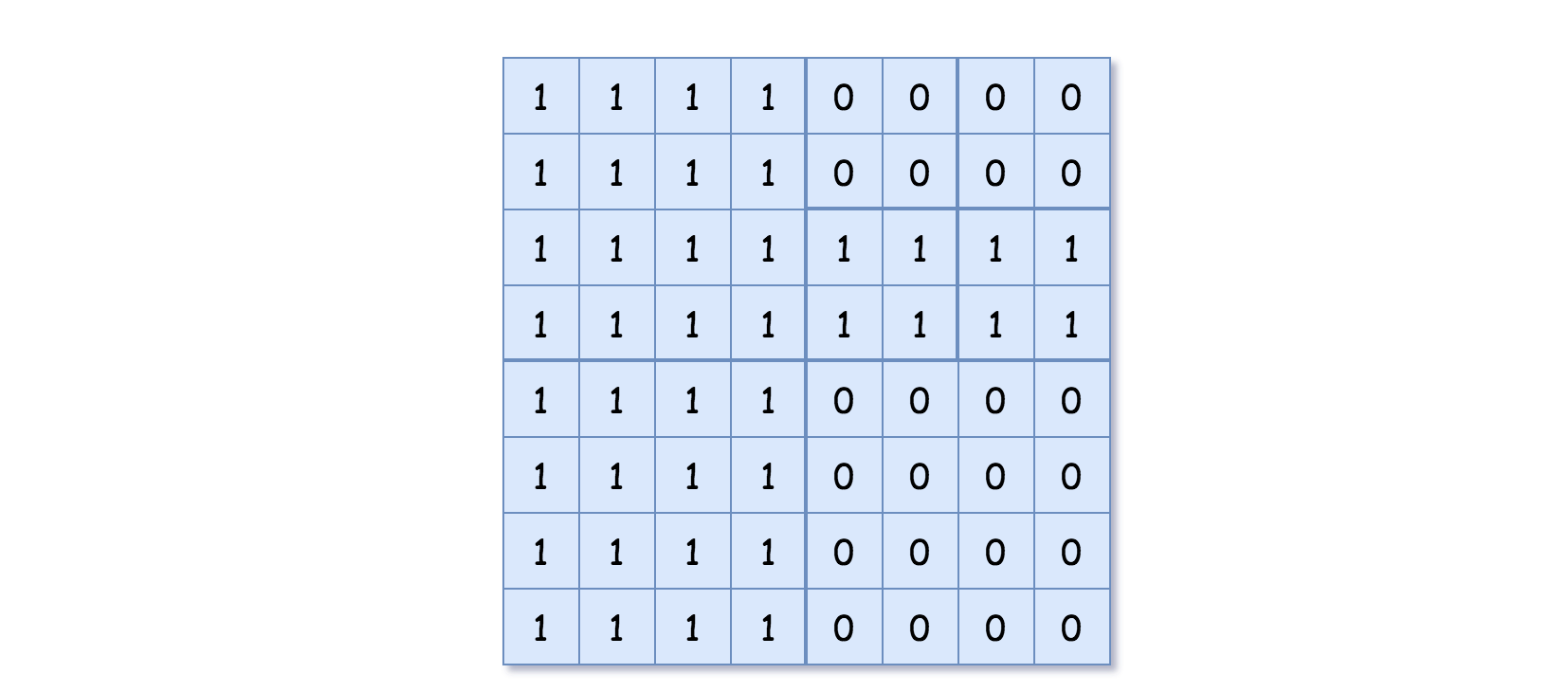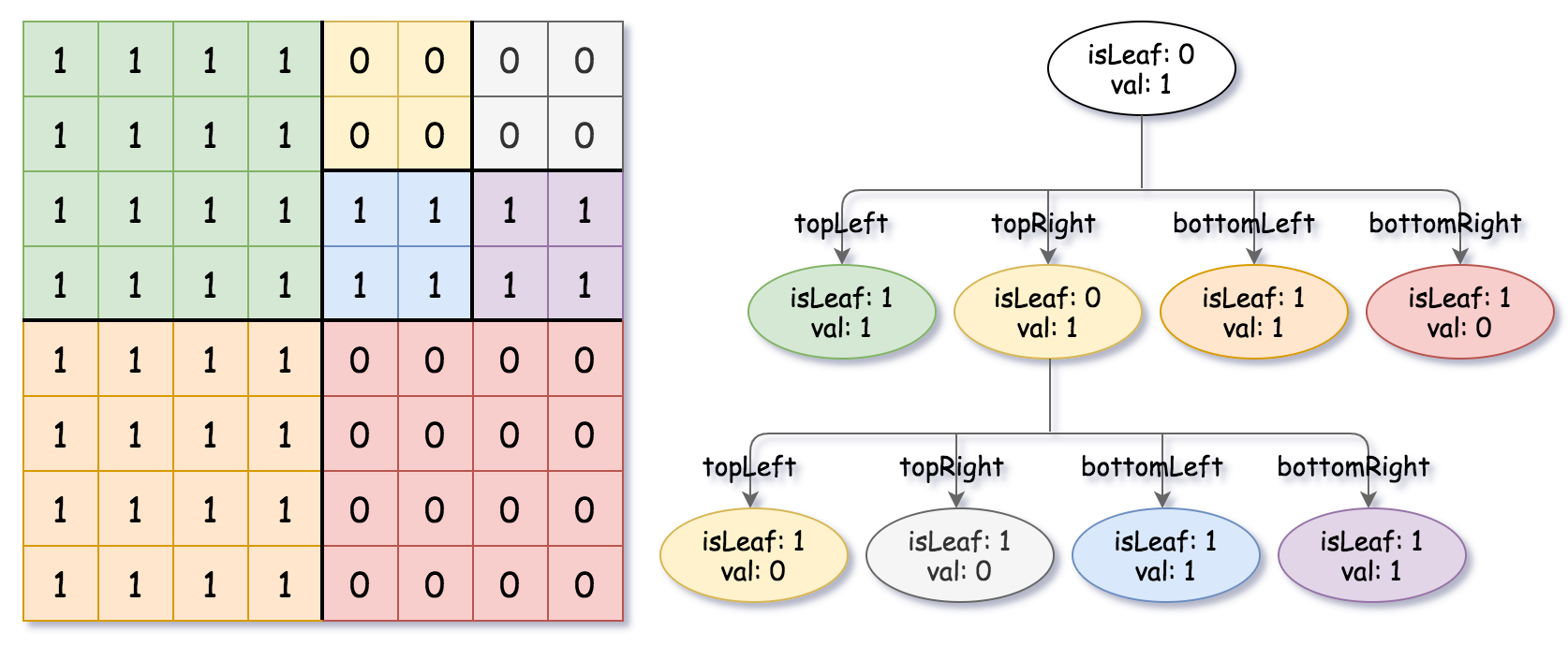Algorithm
Problem Name: 427. Construct Quad Tree
Given a n * n matrix grid of 0's and 1's only. We want to represent the grid with a Quad-Tree.
Return the root of the Quad-Tree representing the grid.
Notice that you can assign the value of a node to True or False when isLeaf is False, and both are accepted in the answer.
A Quad-Tree is a tree data structure in which each internal node has exactly four children. Besides, each node has two attributes:
val: True if the node represents a grid of 1's or False if the node represents a grid of 0's.isLeaf: True if the node is leaf node on the tree or False if the node has the four children.
class Node {
public boolean val;
public boolean isLeaf;
public Node topLeft;
public Node topRight;
public Node bottomLeft;
public Node bottomRight;
}
We can construct a Quad-Tree from a two-dimensional area using the following steps:
- If the current grid has the same value (i.e all
1'sor all0's) setisLeafTrue and setvalto the value of the grid and set the four children to Null and stop. - If the current grid has different values, set
isLeafto False and setvalto any value and divide the current grid into four sub-grids as shown in the photo. - Recurse for each of the children with the proper sub-grid.

If you want to know more about the Quad-Tree, you can refer to the wiki.
Quad-Tree format:
The output represents the serialized format of a Quad-Tree using level order traversal, where null signifies a path terminator where no node exists below.
It is very similar to the serialization of the binary tree. The only difference is that the node is represented as a list [isLeaf, val].
If the value of isLeaf or val is True we represent it as 1 in the list [isLeaf, val] and if the value of isLeaf or val is False we represent it as 0.
Example 1:

Input: grid = [[0,1],[1,0]] Output: [[0,1],[1,0],[1,1],[1,1],[1,0]] Explanation: The explanation of this example is shown below: Notice that 0 represnts False and 1 represents True in the photo representing the Quad-Tree.
Example 2:

Input: grid = [[1,1,1,1,0,0,0,0],[1,1,1,1,0,0,0,0],[1,1,1,1,1,1,1,1],[1,1,1,1,1,1,1,1],[1,1,1,1,0,0,0,0],[1,1,1,1,0,0,0,0],[1,1,1,1,0,0,0,0],[1,1,1,1,0,0,0,0]] Output: [[0,1],[1,1],[0,1],[1,1],[1,0],null,null,null,null,[1,0],[1,0],[1,1],[1,1]] Explanation: All values in the grid are not the same. We divide the grid into four sub-grids. The topLeft, bottomLeft and bottomRight each has the same value. The topRight have different values so we divide it into 4 sub-grids where each has the same value. Explanation is shown in the photo below:
Constraints:
n == grid.length == grid[i].lengthn == 2xwhere0 <= x <= 6
Code Examples
#1 Code Example with Javascript Programming
Code -
Javascript Programming
class Solution {
public Node construct(int[][] grid) {
return helper(grid, 0, 0, grid.length);
}
private Node helper(int[][] grid, int x, int y, int len) {
if (len == 1) {
return new Node(grid[x][y] != 0, true, null, null, null, null);
}
Node result = new Node();
Node topLeft = helper(grid, x, y, len / 2);
Node topRight = helper(grid, x, y + len / 2, len / 2);
Node bottomLeft = helper(grid, x + len / 2, y, len / 2);
Node bottomRight = helper(grid, x + len / 2, y + len / 2, len / 2);
if (
topLeft.isLeaf &&
topRight.isLeaf &&
bottomLeft.isLeaf &&
bottomRight.isLeaf &&
topLeft.val == topRight.val &&
topRight.val == bottomLeft.val &&
bottomLeft.val == bottomRight.val
) {
result.isLeaf = true;
result.val = topLeft.val;
}
else {
result.topLeft = topLeft;
result.topRight = topRight;
result.bottomLeft = bottomLeft;
result.bottomRight = bottomRight;
}
return result;
}
}
Input
Output
#3 Code Example with Python Programming
Code -
Python Programming
class Solution:
def construct(self, grid):
def dfs(x, y, l):
if l == 1:
node = Node(grid[x][y] == 1, True, None, None, None, None)
else:
tLeft = dfs(x, y, l // 2)
tRight = dfs(x, y + l // 2, l // 2)
bLeft = dfs(x + l // 2, y, l// 2)
bRight = dfs(x + l // 2, y + l // 2, l // 2)
value = tLeft.val or tRight.val or bLeft.val or bRight.val
if tLeft.isLeaf and tRight.isLeaf and bLeft.isLeaf and bRight.isLeaf and tLeft.val == tRight.val == bLeft.val == bRight.val:
node = Node(value, True, None, None, None, None)
else:
node = Node(value, False, tLeft, tRight, bLeft, bRight)
return node
return grid and dfs(0, 0, len(grid)) or None
Input
Output
#4 Code Example with C# Programming
Code -
C# Programming
namespace LeetCode
{
public class _0427_ConstructQuadTree
{
public Node Construct(int[][] grid)
{
var N = grid.Length;
if (N == 0) return new Node(true, true);
if (N == 1) return new Node(grid[0][0] == 1, true);
return DFS(grid, 0, N, 0, N);
}
private Node DFS(int[][] grid, int xMin, int xMax, int yMin, int yMax)
{
var same = true;
for (int i = xMin; i < xMax; i++)
{
for (int j = yMin; j < yMax; j++)
if (grid[i][j] != grid[xMin][yMin])
{
same = false;
break;
}
if (!same) break;
}
if (same) return new Node(grid[xMin][yMin] == 1, true);
var node = new Node();
var xMid = xMin + (xMax - xMin) / 2;
var yMid = yMin + (yMax - yMin) / 2;
node.topLeft = DFS(grid, xMin, xMid, yMin, yMid);
node.topRight = DFS(grid, xMin, xMid, yMid, yMax);
node.bottomLeft = DFS(grid, xMid, xMax, yMin, yMid);
node.bottomRight = DFS(grid, xMid, xMax, yMid, yMax);
return node;
}
public class Node
{
public bool val;
public bool isLeaf;
public Node topLeft;
public Node topRight;
public Node bottomLeft;
public Node bottomRight;
public Node()
{
val = false;
isLeaf = false;
topLeft = null;
topRight = null;
bottomLeft = null;
bottomRight = null;
}
public Node(bool _val, bool _isLeaf)
{
val = _val;
isLeaf = _isLeaf;
topLeft = null;
topRight = null;
bottomLeft = null;
bottomRight = null;
}
public Node(bool _val, bool _isLeaf, Node _topLeft, Node _topRight, Node _bottomLeft, Node _bottomRight)
{
val = _val;
isLeaf = _isLeaf;
topLeft = _topLeft;
topRight = _topRight;
bottomLeft = _bottomLeft;
bottomRight = _bottomRight;
}
}
}
}
Input
Output
